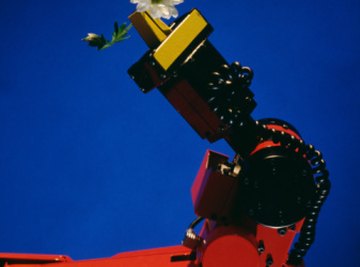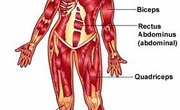
Simple electrical, mechanical, mathematical and computational experiments can be performed using robotic arms and hands. You can own a robotic arm for use in school science projects for as little as $50. With precision controls, a 300 degree angle of arm rotation, gripper and wrist motions, it is worth the investment.
Build a Robot Arm and Hand
Purchase a robotic arm kit and show your students the components and tools required to construct the finished product. Ask them to study the instructions and ask a few volunteers will help show the class what is involved in setting up a robotic arm by reading out the instructions. Help another small team build the arm from scratch. Explain what the different components are for and what they do in the finished robotic arm. If you wish to specialize in biology and engineering, since the two are linked in the field of biomechanics, try to describe each robotic component as if it were a body part. For example, the wires could be the blood vessels, carrying the energy to the grabber, or hand.
Compare Robot with Human
A simple comparison between the robot and child's arm/hand can inspire a greater level of understanding about the importance of their body and the relevance of computer modeling and prosthetics. Ask each child to write the differences in a table with “robot” and “human” headings. Look for comparisons such cold metal versus warm skin, battery powered versus energy from food or grabber versus hand and fingers. Ask the children to also state the similarities they observe, particularly when the arm is in operation. Obviously, the level of detail you explore depends on the age group.
Lifting Different Weights
Each robot requires batteries, which power a small electric motor inside the robot’s core. Explain this system to students. Ask them to try lifting several small weights with their own arms, and then ask them to perform the same weight lifts using the robot arm and grabber. Work upwards from the lowest weight. Find out which is the first weight the children cannot lift and which the robot cannot lift. Record the results in a comparison table.
Measure Degrees of Freedom
Distribute a new tool for the children to try: the basic protractor. Ask them to rotate the robotic arm from one maximum position to another, and then measure the rotation angle and total arc using the protractor. Also ask them to measure the total vertical reach of the robotic arm, and perhaps they can compare it to their own by working in pairs and measuring one another’s maximum vertical reach using a tape measure. The OWI Robotic Arm Edge, for example, has a vertical reach of 15 inches, a horizontal reach of 12.6 inches and a rotational arc at the hand position of 180 degrees.
List Different Robot Uses in the Real World
For older students, such as 15 or 16, develop their understanding of real world applications further -- into the realm of full body robots and medical assistance machines such as working prosthetic arms, legs and hands. Ask the students to find three different medical applications of a robotic arm, list why a robotic arm is useful compared to a normal arm and three reasons why someone might require a prosthetic. Examples include physiotherapy exercise robots, replacement limbs and paralysis research in the field of neuroscience. A 25-year-old paraplegic made history in 2004 after he had 96 electrical sensors implanted into his brain to control a robot arm, as described by Science Line.
References
About the Author
Natasha Parks has been a professional writer since 2001 with work published online and in book format for "Thomson Reuters," the "World Patents Index" and thomson.com. Her areas of expertise are varied and include physics, biology, genetics and computing, mental health, relationships, family crises and career development. She holds a Bachelor of Science in Biophysics from King's College, London.
Photo Credits
Jupiterimages/Photos.com/Getty Images
